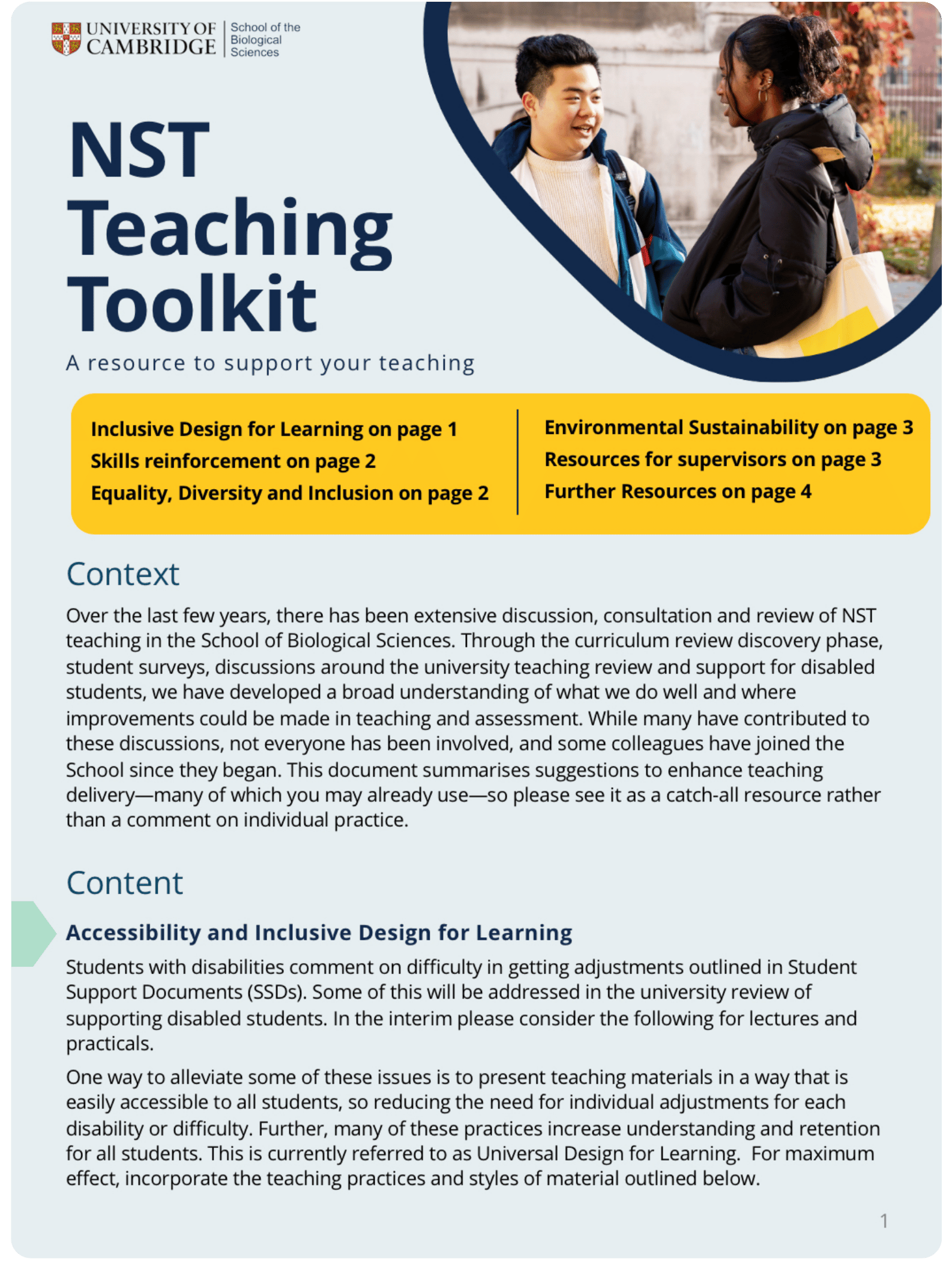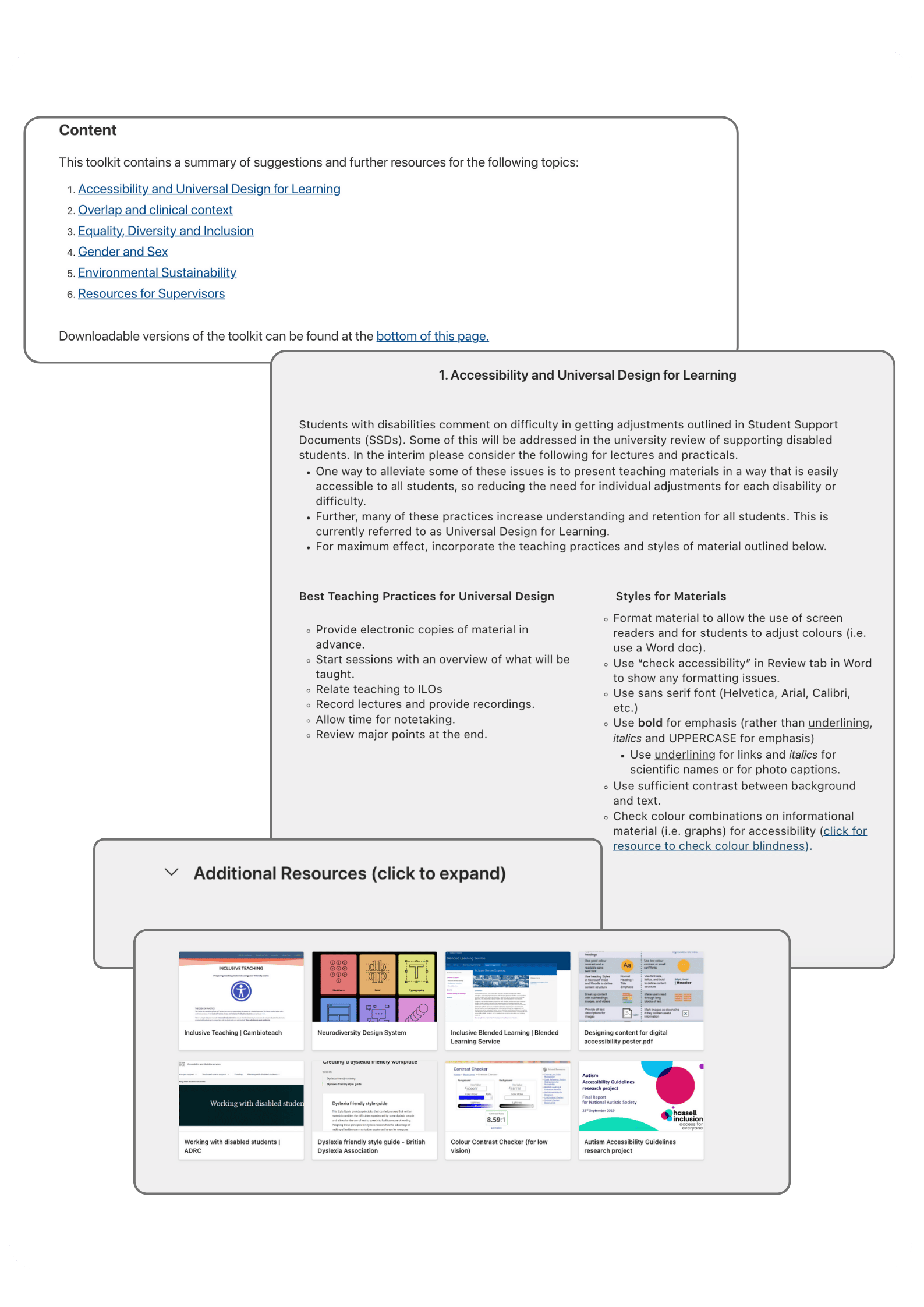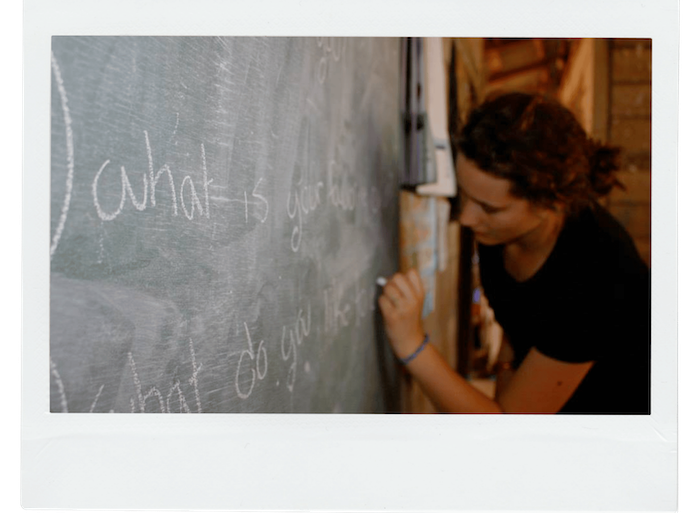
Connect
This practical toolkit was developed to support teaching staff in the biological sciences at Cambridge, helping them enhance their curricula and teaching practices across key areas like inclusive design, accessibility, content reinforcement, diversity and inclusion, and environmental sustainability. With quick, easy-to-digest guidance and links to deeper resources, it was designed to offer meaningful support without adding to staff workload. The goal was to provide a clear, approachable resource that empowers educators to deliver more inclusive, engaging, and future-focused science teaching.
Sample view (download version)

Sample view (online version)

Collaboration and engagement- I listened carefully to staff and students while researching policy requirements and best practices to create a strong foundation that others could build on. It was rewarding to see stakeholders take this content, challenge it, and shape it into something meaningful for their purposes.
To balance technical accuracy with emotional intelligence when designing content that addresses complex, values-driven topics. Creating a resource for a diverse audience meant using both policy knowledge and soft skills like empathy, careful framing, and inclusive language. Just as importantly, the toolkit itself encourages staff to develop both their technical and interpersonal approaches to teaching—supporting not just what they teach, but how they connect with learners.
Long-term maintenance-
To make the toolkit accessible for different audiences, I designed it in three formats with UX in mind—but this also added complexity to maintaining it long-term. While I was happy to front-load the design work, someone else will upkeep this toolkit. If I were to do it again, I’d explore ways to simplify upkeep without compromising the user experience—so the resource remains practical, usable, and easy to update, no matter who takes it forward.
This project focused on strengthening the peer feedback experience for students at Harvard University by combining thoughtful content design with the right technology. I worked closely with staff to research and recommend software platforms that aligned with their teaching goals as well as created clear, student-friendly resources to guide learners through the process and set expectations. By supporting both the technical setup and the learning experience, the project helped build a more engaging, structured, and supportive environment for meaningful peer-to-peer learning.
Sample documents and activities

The quality and impact of the final resources we delivered. This was a true end-to-end project—selecting the right platform, creating clear, student-friendly materials, and ensuring everything aligned with the needs of both faculty and learners. The professors were really pleased with the outcome, and it was especially rewarding to see some of the materials even shared with an educator at the Smithsonian. It was a great example of strong teamwork and thoughtful design coming together to create something useful and lasting.
Just how valuable open communication and true collaboration are in creating effective learning solutions. Our team worked closely together to explore options, share ideas, and develop a range of resources—each bringing different strengths to the table. In the end, professors selected elements from across our work to create the best possible experience for their students. It was a great reminder that the best outcomes often come from a mix of perspectives and strong teamwork.
As the project progressed, I noticed some miscommunications within the team, so I facilitated clearer collaboration by setting up video check-ins to realign and keep things on track. While those conversations helped a lot, I realized how valuable it would have been to establish a shared understanding and clear goals right from the start. If I were to do it again, I’d invest more time upfront to create that alignment early on—ensuring everyone felt confident in the direction and fully connected to the shared aim.
As a co-leader of a volunteer team in Thailand and Cambodia, I was actively involved on the ground, overseeing all aspects of a multi-site teaching and development initiative. This included logistics, scheduling, risk management, and stakeholder communication, alongside mentoring volunteers and delivering English and basic skills teaching in both urban centers and rural communities. Working in partnership with a range of NGOs, the project required adaptive leadership, cross-cultural communication, and strong interpersonal awareness to create meaningful, respectful learning experiences across diverse settings.

The relationships built throughout this project—both with our partner organizations and with the local communities we worked alongside. Navigating complex logistics across two countries required adaptability, but what made the experience meaningful was staying grounded in people-first leadership. I worked hard to create a supportive environment for our volunteer team, especially as they stepped into unfamiliar, cross-cultural settings. Building trust and connection across so many different contexts was one of the most rewarding parts of the work.
This experience taught me a great deal about resilience, adaptability, and the importance of leading with empathy—especially in high-pressure situations. I had proactively sought out training beforehand to prepare for working in complex environments, and that preparation became essential. During the trip, we faced a potential military coup in Thailand and medical emergencies in a Cambodian village—moments that required calm decision-making, clear communication, and steady leadership. I also saw how powerful peer support and informal leadership can be in uncertain situations. I learned that strong leadership isn’t just about having the answers—it’s about creating clarity, emotional safety, and trust when others need it most.
While we prepared thoughtfully and supported one another well in the moment, this experience made me reflect on the value of having stronger structures in place from the outset. If I were to do it again, I would look for more opportunities to advocate early on for clearer protocols and shared contingency planning. It’s something I’ve come to appreciate even more—how a well-prepared foundation can make a meaningful difference when working in complex, high-stakes environments.
Paragraph of text
Paragraph of text
Paragraph of text
Paragraph of text


text
text
text
text
text
text